Configuring and managing your server
Xaero's Minimap Mod

Xaero's Minimap Mod is a popular mod for Minecraft that adds a minimap to the game. The mod is available on all Minecraft version and can be installed on both single-player and multiplayer games. In this tutorial, we will guide you on how to install, configure and use Xaero's Minimap Mod.
Installing Xaero's Minimap Mod on client
Before you start, make sure you have Minecraft installed on your computer.
Download the Xaero's Minimap Mod from a trusted source. You can download the mod from the official Xaero's Minimap Mod website or from CurseForge.
Make sure you have Minecraft Forge installed. If you don't, download and install it from the official website).
Locate the Minecraft game directory on your computer. On Windows, it is usually located in the %appdata%.minecraft directory. On Mac, it is usually located in the ~/Library/Application Support/minecraft directory.
Open the mods folder in the game directory. If there isn't one, create a new folder and name it "mods".
Move the downloaded Xaero's Minimap mod file into the mods folder.
Launch Minecraft and make sure the mod is installed by checking the mods list in the main menu.
Installation on server
Open the WebFTP on your panel.
Drag and drop the downloaded Xaero's Minimap Mod .jar file into the mods folder.
Restart your server, and launch Minecraft.
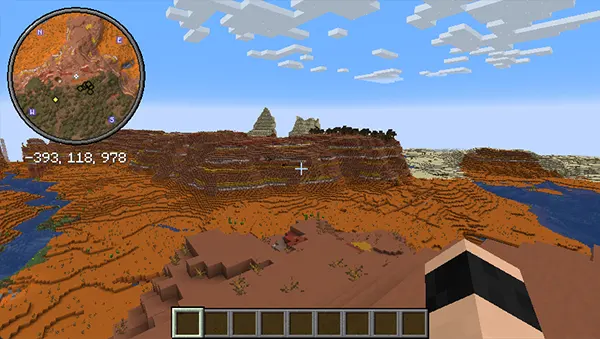
Xaero's Minimap Controls
Using Xaero's Minimap is easy, and it has only a few controls that you need to be aware of. The first control you need to know is W, which opens a larger version of the minimap, allowing you to see greater distances. To access the mod settings, press Y instead. Here, you can configure most features of your minimap, such as the radar, size, shape, and more.
Pressing B allows you to quickly access the new Waypoint screen. On the other hand, pressing U opens up the Waypoints menu, where you can see a list of Waypoints, teleport to them, or remove them.
Creating Waypoints
Waypoints are a significant feature of Xaero's Minimap that helps you navigate your way through Minecraft. To create a Waypoint, press the B key, and a screen with several options will appear. You can change the color of the Waypoint and input a name. Your current coordinates will appear on the menu, but you can input your own. It's even possible to change the dimension.
Once you create the Waypoint, it will be saved and visible on the minimap, as well as in the game world when you're looking in its direction. Alternatively, you can quickly create Waypoints at your current location by pressing +. If you need to edit or delete an existing Waypoint, press U instead to head to the Waypoints menu.
Minimap Shape and Position
You can customize the shape and position of the minimap by opening the settings and pressing Y. On this screen, there's a Position button that allows you to select the minimap and drag it to a location of your choice. You can also change the shape of Xaer's Minimap by setting it to be a Square or Circle under View Settings of the main settings screen.
Entity Radar
One of the best features of Xaero's Minimap is the Entity Radar that shows you where mobs and players are located. By default, Minecraft mobs appear as a small yellow circle on the minimap, whereas the player is a white circle, and any drops on the ground appear as red circles.
If you want mobs to look like icons instead, open the menu by pressing Y and select Entity Radar Settings. Look for the Display Icons button and make sure that it says Always to save your changes. You can also enable nameplates on the minimap.
Configuring Xaero's Minimap
To access the settings, press the "Y" key on your keyboard. This will open the mod's menu, which contains several tabs for different configuration options. Let's go through each tab and explain what each setting does.
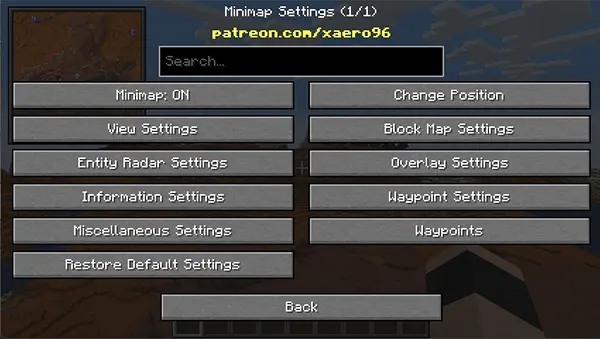
View Settings
You can customize the appearance of the minimap. Here, you can change the shape of the minimap from the default square to a circle. You can also adjust the size of the minimap from small to large, and set the minimap to be shown in either the top right, top left, bottom right, or bottom left corner of your screen.
In addition, you can also choose to show or hide various elements of the minimap, such as the player arrow, the border, the grid, the waypoints, and the mob icons. You can also adjust the opacity of the minimap and set it to either rotate or remain fixed.
Moreover, there are additional view settings available for when the minimap is enlarged. These settings include the ability to adjust the opacity and scale of the enlarged minimap, as well as options for the background color and border.
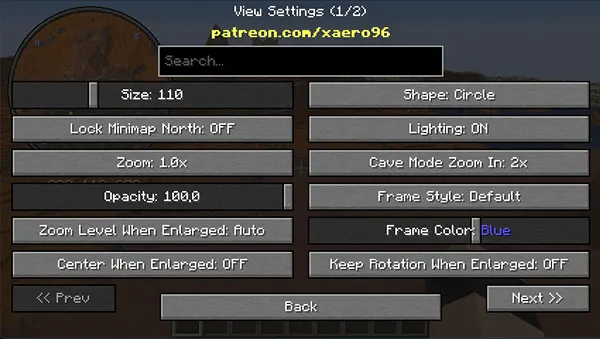
- Size: This setting allows you to adjust the size of the minimap on your screen.
- Lock Minimap North: This setting allows you to lock the minimap to always show north at the top.
- Zoom: This setting allows you to adjust the zoom level of the minimap.
- Opacity: This setting allows you to adjust the transparency of the minimap.
- Zoom Level When Enlarged: This setting allows you to adjust the zoom level of the minimap when it is enlarged.
- Center When Enlarged: This setting allows you to center the minimap when it is enlarged.
- Shape: This setting allows you to change the shape of the minimap to either square or circular.
- Lighting: This setting allows you to turn on or off the lighting effects on the minimap.
- Cave Mode Zoom In: This setting allows you to zoom in when using cave mode.
- Frame Style: This setting allows you to change the style of the frame around the minimap.
- Frame Color: This setting allows you to change the color of the frame around the minimap.
- Keep Rotation When Enlarged: This setting allows you to keep the rotation of the minimap when it is enlarged.
- Toggled Enlarged Minimap: This setting allows you to toggle the enlarged minimap on or off.
- Hide When Under F3: This setting allows you to hide the minimap when you press the F3 key.
- Potion Effects Push Box: This setting allows you to adjust the position of the potion effects push box.
- Hide When Under Screen: This setting allows you to hide the minimap when you open a GUI or inventory screen.
- Boss Health Push Box: This setting allows you to adjust the position of the boss health push box.
Entity Radar Settings
You can customize the way mobs and other entities appear on the minimap. To access this page, press the Y key to open the main menu and then click on the "Entity Radar Settings" button. Here's what you can do on this page: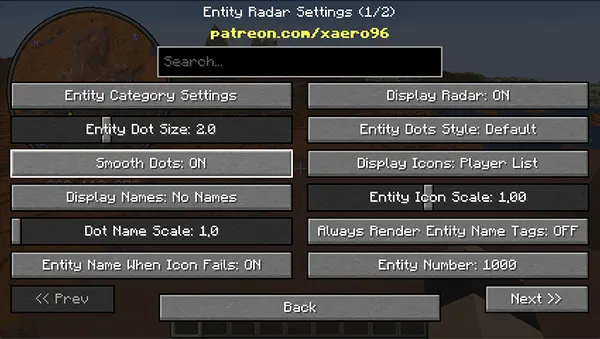
- Entity category settings: This setting allows you to specify which type of entities you want to show on the radar. You can choose to show all entities, only animals, only monsters, or only players.
- Entity dot size: This setting controls the size of the dots used to represent entities on the radar. You can make them smaller or larger depending on your preference.
- Smooth dots: This option smooths out the edges of the entity dots, giving them a more polished appearance.
- Display Names: This setting determines whether or not to display the names of entities on the radar.
- Dot Name Scale: This option allows you to adjust the size of the text used for entity names.
- Entity Name When icon Fails: This option allows you to display the name of an entity when its icon fails to load.
- Display Radar: This setting allows you to turn the entire radar display on or off.
- Entity Dots Styles: This option lets you choose from various styles of dots to represent entities on the radar.
- Display Icons: This setting allows you to display icons instead of dots to represent entities on the radar.
- Entity Icon Scale: This option allows you to adjust the size of the icons used to represent entities.
- Always Render Entity Name Tags: This option determines whether or not to always display the name tags of entities, even if they are not visible.
- Entity Number: This option controls the number of entities that are shown on the radar.
- Entity Height limit: This option allows you to set a limit on the maximum height of entities that are displayed on the radar.
- Min Y Distance For Depth Fade: This option determines how quickly entities fade out as they move further away from the radar.
- Main Entity As: This setting lets you choose which entity to highlight as the main entity on the radar.
- Arrow Scale: This option allows you to adjust the size of the arrows used to indicate the direction of entities on the radar.
- Arrow Opacity: This setting controls the transparency of the arrows used to indicate the direction of entities on the radar.
- Display Party/Ally Players: This setting allows you to show or hide party/ally players on the radar.
- Show Entity Depth: This option determines whether or not to display the depth of entities on the radar.
- Display Entity Y Level: This setting allows you to show or hide the Y level of entities on the radar.
- Main Entity Dot Size: This setting controls the size of the dot used to represent the main entity on the radar.
- Arrow Color: This option lets you choose the color of the arrows used to indicate the direction of entities on the radar.
- Render Radar Over Frame: This setting determines whether or not to render the radar over the Minecraft game frame.
Block Map Settings
Xaero's Minimap has a Block Map feature that allows players to see a top-down view of the terrain they have explored. This can be useful for planning out builds or finding specific types of biomes. Here's a detailed explanation of the Block Map Settings page in Xaero's Minimap:
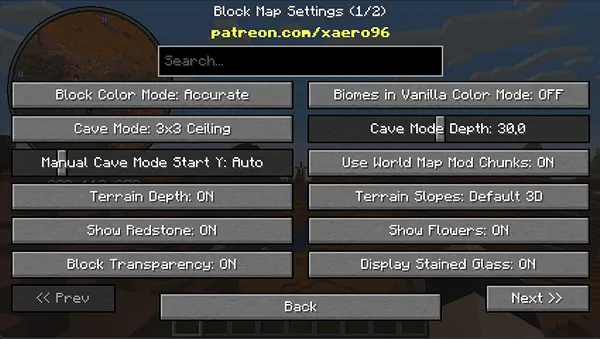
- Block Color Mode : This setting allows you to change how the different blocks in the map are colored, limited to two options: Accurate or Vanilla.The Accurate Block Color Mode will display each block on the minimap with its true color, making it easier to distinguish between different blocks. This can be particularly helpful for finding specific types of blocks or locating areas with certain resources.The Vanilla Block Color Mode, on the other hand, uses a simplified color scheme that makes it easier to see the overall terrain and structures. In this mode, most blocks are displayed as either green or brown, while some specific blocks have unique colors (such as water being blue).
- Cave Mode: 3x3 Ceiling : Available Cave Mode settings are indeed 1x1, 3x3, and 5x5 showing the area of 3x3 ceiling around the player, with the option to turn it off as well
- Manual Cave Mode Start Y Auto : This setting allows you to manually set the start Y-level of the cave mode. When it is turned auto, the mod will automatically determine the start Y-level based on the player's position.
- Terrain Depth : This setting allows you to turn the terrain depth feature on or off. When it is turned on, the map will display the terrain depth below the player's position.
- Show Redstone : This setting allows you to turn the redstone display on or off. When it is turned on, the map will show the location of redstone blocks.
- Block Transparency : When this setting is turned on, the blocks in the map will become partially transparent, allowing you to see through them.
- Biomes in Vanilla Color Mode : When this setting is turned on, the biomes will be displayed in the vanilla color mode.
- Cave Mode Depth : This setting allows you to adjust the depth of the cave mode, which is how far down it will display caves.
- Use World Map Mod Chunks : This setting allows you to use the chunks from the world map mod to display the terrain, rather than generating the terrain from the game.
- Terrain Slopes: Default 3D : This setting allows you to adjust the slope of the terrain in the map. There are three options available: Default 3D, Flat, and Overhead.
- Show Flowers : When this setting is turned on, the map will show the location of flowers and other plants.
- Display Stained Glass : When this setting is turned on, the map will display stained glass blocks in their actual color.
- Adjust Y for short block : This setting will adjust the Y coordinate of the player when viewing short blocks (such as slabs or stairs) on the block map, to prevent the blocks from obstructing the view of the player. When enabled, the Y value will be increased slightly so that the player appears to be standing on top of the short block, rather than behind it.
- Ignore server Heightmaps : Heightmaps are data files that Minecraft uses to generate terrain. When this setting is enabled, Xaero's Minimap will ignore the heightmap data provided by the server and instead use its own calculations to generate the block map. This can sometimes improve performance, but may result in slight inaccuracies in the generated map.
- Anti-Aliasing : Anti-aliasing is a technique used to smooth jagged edges in graphics. When enabled, Xaero's Minimap will use anti-aliasing to create smoother edges for blocks on the block map, making the map look more polished and easier to read. However, enabling anti-aliasing may also reduce performance slightly.
Overlay Settings
The Overlay settings in Xaero's Minimap allow you to display additional information on your map overlay.
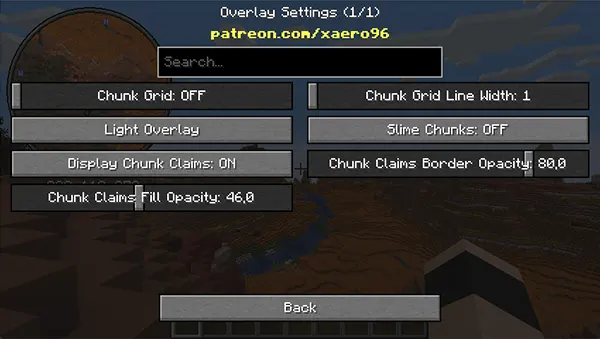
- Chunk Grid: This option displays a grid overlay on the minimap that represents the boundaries of each chunk in Minecraft. You can turn it on or off as per your preference.
- Light Overlay: This setting helps you see areas that have a low light level, so you can quickly identify any areas that might be dangerous. It displays an overlay of the light levels in different colors, so you can quickly see where you might need to add some light sources to prevent hostile mobs from spawning.
- Display Chunk Claims: This setting is useful for multiplayer servers. When it's turned on, it displays a border around each player's claimed chunks, which can help you avoid accidentally building on someone else's property.
- Chunk claims Fill Opacity: This setting adjusts the opacity of the color fill for claimed chunks, so you can adjust the visibility of the claimed areas.
- Chunk Grid Line Width: This setting adjusts the width of the lines in the chunk grid overlay.
- Slime Chunks: This option helps you find slime chunks in Minecraft. When it's turned on, the minimap displays which chunks in your world are slime chunks, so you can quickly find the best spots to farm slime.
- Chunk Claims Border Opacity: This setting adjusts the opacity of the border around claimed chunks, so you can adjust the visibility of the borders.
Waypoint Settings
Waypoints in Xaero's Minimap are user-defined markers that can be placed on the map for navigation or reference. They can be customized with names, icons, and colors, and can be set to appear on the map both in-game and in the minimap interface. Other features of the waypoint system include death points, global temporary waypoints, and cross-dimensional teleportation.
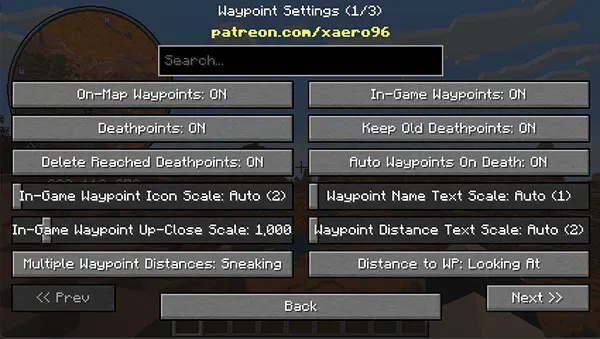
- On-Map Waypoints: This setting allows you to turn on or off the display of waypoints on the map.
- Deathpoints: This setting allows you to turn on or off the display of deathpoints (locations where you have died) on the map.
- Delete Reached Deathpoints: If turned on, this setting automatically deletes deathpoints from the map when you reach them.
- In-Game Waypoint Icon Scale: This setting adjusts the size of waypoint icons displayed in the game.
- In-Game Waypoint Up-Close Scale: This setting adjusts the size of waypoint icons when viewed up close.
- Multiple Waypoint Distances: This setting controls how distances to multiple waypoints are displayed on the map.
- In-Game Waypoints: This setting allows you to turn on or off the display of waypoints in the game.
- Keep Old Deathpoints: If turned on, this setting keeps deathpoints on the map even after you have reached them.
- Auto Waypoints On Death: If turned on, this setting automatically adds a waypoint at the location where you died.
- Waypoint Name Text Scale: This setting adjusts the size of text for waypoint names.
- Waypoint Distance Text Scale: This setting adjusts the size of text for waypoint distances.
- Distance to WP: This setting controls how distances to waypoints are displayed on the map.
- WP Name Above Distance: If turned on, this setting displays waypoint names above their respective distances.
- Render All Waypoint Sets: If turned on, this setting displays all waypoint sets on the map.
- Max WP Render Distance: This setting controls the maximum distance at which waypoints are displayed on the map.
- Min WP Render Distance: This setting controls the minimum distance at which waypoints are displayed on the map.
- Waypoint Opacity in Game: This setting adjusts the opacity of waypoint icons displayed in the game.
- Waypoint Opacity on Map: This setting adjusts the opacity of waypoint icons displayed on the map.
- Always Display Distance to WP: If turned on, this setting always displays the distance to the closest waypoint.
- WP Distance Vertical Angle: This setting controls the vertical angle at which waypoint distances are displayed on the map.
- WP Distance Horizontal Angle: This setting controls the horizontal angle at which waypoint distances are displayed on the map.
- Convert Distance to KM at: This setting allows you to choose the distance at which distances are displayed in kilometers.
- Waypoint Distance Precision: This setting controls the number of decimal places used for displaying waypoint distances.
- On-Map Waypoint Scale: This setting adjusts the size of waypoint icons displayed on the map.
- Global Temporary Waypoints: If turned on, this setting allows you to create temporary waypoints that are saved across worlds.
- Cross-Dimensional TP: If turned on, this setting allows you to teleport to waypoints in other dimensions.
- New Waypoints to Bottom: If turned on, this setting adds new waypoints to the bottom of the waypoint list.
- Hide Waypoint Coordinates: If turned on, this setting hides the coordinates of waypoints from the waypoint list.
- Compass: This setting allows you to turn on or off the display of a compass on the map.
- Compass Scale On-Map: This setting adjusts the size of the compass displayed on the map.
- Default Teleport Command: This setting allows you to customize the command used for teleporting to waypoints.
- Use Y with Particle When TP: If turned on, this setting shows a particle effect at the Y-coordinate when teleporting.
- Hide IPs/World Names: If turned on, this setting hides the IPs and world names from the multiplayer server list.
- Compass Over Everything: If turned on, this setting displays the compass over all other map elements.
- Compass: This section contains settings for the compass on the minimap.
- Compass Scale On-Map: This setting adjusts the size of the compass icon on the minimap.
- Default Teleport Command: This setting allows you to specify a custom teleport command to be used with the waypoints.
- Use Y with Particle When TP: When enabled, it shows a particle effect at the location you teleport to.
- Compass Over Everything: This setting determines whether the compass icon should appear on top of other minimap elements.
- Compass Shadow Color: This setting allows you to change the color of the shadow behind the compass.
- North Compass Color: This setting allows you to change the color of the compass when it's facing north.
To manage waypoints, you can access the Waypoints settings page with "U" Key. From there, you can create, edit, delete, and manage various aspects of your waypoints, such as names, icons, distances, and more.
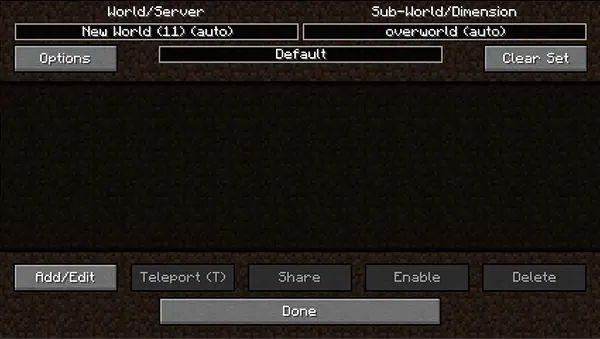
You can add a waypoint by pressing the "B" Key.
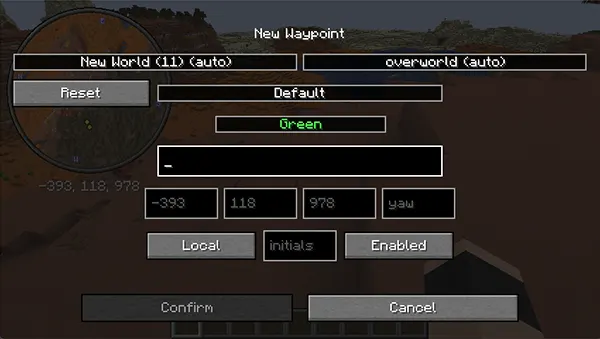
Conclusion
In conclusion, Xaero's Minimap is a must-have mod for Minecraft players who want to navigate the game world with ease. With its tons of features, including Enlarged Maps, Cave Views, Mob Radars, and Waypoints, Xaero's Minimap is one of the most flexible map mods available.
